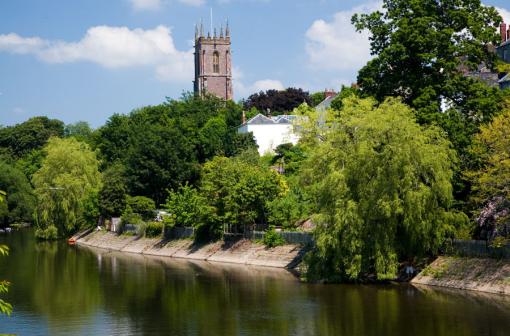 River Exe in Tiverton
River Exe in Tiverton
Tiverton is a busy market town situated in the middle of Devon and a convenient centre for both coasts, the moors and the cities of Exeter and Plymouth. The name was originally Twyfyrde, meaning town of two fords, and Tiverton stands on two rivers - the Lowman and the Exe. It was thought to have been a Saxon settlement founded in the 7th century.
There is the site of a Roman Auxiliary Fort near Tiverton, believed to date from the middle of the 1st century. Tiverton Castle was originally built in the early 12th century and was the seat of the Earls of Devon for several centuries. It was rebuilt and enlarged in 1293, at which time it was owned by the Courtenay family, who married into the Royal family in 1495. There is an interesting collection of Civil War arms and armour in the castle, which is a favourite venue for weddings.
The Tiverton Museum of Mid Devon Life contains the largest social history collection in the South-West of England, in addition to displays on agriculture, industry and transport. This interesting enterprise has won the Museum of the Year Award. The Tiverton Craft Centre is a Victorian shop with showrooms exhibiting many examples of local craft work including pottery, basketwork, painting and slate work.
The town was once the industrial centre of Devon’s fabric trade and the rivers provided sources of power for the woollen industry. The Heathcoat Lace Factory, which has been in operation since 1816, continues the trade today. The town has a small, busy, shopping centre and a local cinema. There are still many fine old merchant’s buildings in the town. Buildings of note include the Old Police Station on St Andrew’s Street, which has been restored and converted into private dwellings, and the Council Offices.
St Peter’s Church was restored in 1517, when a richly decorated porch and chapel were added. The finest Georgian church in Devon is said to be St George’s Church, a building with elegant ceilings and galleries. It was erecting following a devastating fire in Tiverton in 1731.
The famous public school was founded by Peter Blundell in 1599 and the Old Blundell’s School building, beside the Loman Bridge, was erected in 1604. The author R. D. Blackmore was educated here and used the school as a setting for one of the scenes in Lorna Doone. The school moved to its present site in 1880.
The Grand Western Canal was built in 1814 to carry limestone from local quarries to Tiverton. It was originally intended to link this waterway to Bridgwater and the Bristol Channel, but this never happened. Today the canal is a pleasant venue for boat trips and horse drawn barge trips.
There are many interesting places to visit around Tiverton. One of these is the National Trust property, Knightshayes Court at Bolham, two miles North of Tiverton. This Gothic Victorian house, built in 1869, is set in acres of attractive gardens. Bickleigh Castle is on the Exeter road out of town, and boasts a medieval hall, chapel, exhibitions, gardens and shop.
Of course, Tiverton lies close to the heart of Devon, in the Exe Valley. It has the ideal location for visiting the county town of Exeter in addition to being close to the wonderful Exmoor and Dartmoor National Parks. It is also within reach of both coasts of the county.



